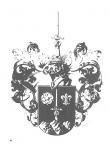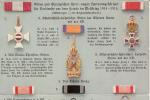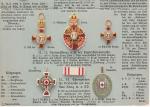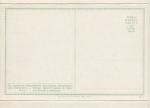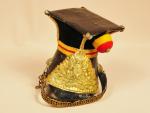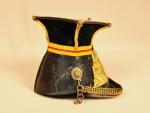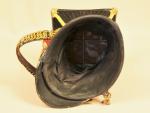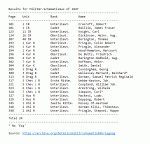-
Posts
581 -
Joined
-
Last visited
-
Days Won
2
Content Type
Profiles
Forums
Blogs
Gallery
Events
Store
Everything posted by Trooper_D
-
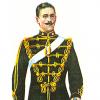
Austria-Hungary Order of the Golden Fleece
Trooper_D replied to Carol I's topic in Austro-Hungarian Empire
Do you have the 'back story' for this extraordinary piece, Carol? -

Austria-Hungary KuK Soldiers wearing medals - show your photos
Trooper_D replied to IrishGunner's topic in Austro-Hungarian Empire
Wow, that’s cutting it fine! Good find, Iver. For those who can read Czech - I can't - there is more about this gentleman on pp 79-81 of Heraldická ročenka Praha : Heraldická společnost v Praze, 1993 20 (Google Translate tells me that this is 1993 Heraldic Yearbook of the Prague Heraldry Society). It can be found here, http://www.historie.hranet.cz/heraldika/hr/hr1993.pdf For those who are interested in such things (i.e. me) here is his coat of arms from his Diploma of Nobility (from the same source). -

Serbia Serbian and Yugoslav Diplomatic-Consular Uniforms
Trooper_D replied to paja's topic in Southern European & Balkan States
These are wonderful examples, Paja, and will make this thread an extremely useful resource for someone researching the subject in the future - which is what this site is all about, really, isn't it?! -

Austria-Hungary KuK Soldiers wearing medals - show your photos
Trooper_D replied to IrishGunner's topic in Austro-Hungarian Empire
Thanks for the translation. 'Service' - well that comes back to your point about a suitably sized donation, doesn't it -

Austria-Hungary KuK Soldiers wearing medals - show your photos
Trooper_D replied to IrishGunner's topic in Austro-Hungarian Empire
For general interest, and because it is relevant to this thread, I am posting a complete scan (but in three parts) of the front (and part of the rear) of a postcard I own, which shows the major Austro-Hungarian ODMs. It's interesting to see photos of them when they were shiny and new, isn't it? -

Austria-Hungary KuK Soldiers wearing medals - show your photos
Trooper_D replied to IrishGunner's topic in Austro-Hungarian Empire
Thank you, as always, Margraf for this information - particularly that about the Red Cross award. I hesitate to call it a 'paid-for' award but that is rather what it sounds like (it is such an attractive decoration, who would be able to resist!). I wonder if any German speakers might be able to add anything to this, using this extract from a contemporary three-part folding postcard showing the major Austro-Hungarian ODMs, from my collection? -

Serbia Serbian and Yugoslav Diplomatic-Consular Uniforms
Trooper_D replied to paja's topic in Southern European & Balkan States
Thanks for this, Paja.I was hoping it might be for some items of uniform however, as it is associated with a retired officer, I suppose I can still consider it 'militaria' -

Austria-Hungary KuK Soldiers wearing medals - show your photos
Trooper_D replied to IrishGunner's topic in Austro-Hungarian Empire
These three chaps seem to have done well for themselves! I am particularly interested in the man on the right, wearing what I believe is the Rote Kreuz Ehrenkreuz. Can anyone tell me what this was awarded for, please? Any other information would also be welcome. -

Serbia Serbian and Yugoslav Diplomatic-Consular Uniforms
Trooper_D replied to paja's topic in Southern European & Balkan States
... and also of Belgrade (see attached). I had forgotten I had this in my collection until I reread this thread. btw can you tell me what the invoice is for, please? -

Serbia Serbian and Yugoslav Diplomatic-Consular Uniforms
Trooper_D replied to paja's topic in Southern European & Balkan States
You've been very busy, Paja! I shall give this thread a close reading when I have a bit more time. One quick question: were these uniforms made in Serbia/Yugoslavia and, if so, do you know the tailor or tailors who had the skills to produce them? As far as the UK is concerned, today only one or two tailors still make diplomatic uniforms - perhaps the best is Henry Poole & Co who also make court dress, https://henrypoole.com/livery/ -
Thank you for posting this photo of a diplomatic uniform, Paja. I am fascinated by them and am always interested to see examples from different parts of the world. Do you know of an online source which would set out, in visual form, the specifications followed by Serbian diplomats at this time - or, at least, shows more images of them?
-

lancers helmet
Trooper_D replied to blueman's topic in Great Britain: Militaria: Badges, Uniforms & Equipment
It looks like the czapka below is either from the same 'stable' or is blueman's helmet before restoration. 1600 x 1200 images are available here (click on 'Enlarge'), http://www.rarusnet.com/product_info.php?products_id=12417 Note that the inside of the helmet, and the wire framework from which it is constructed, is visible in one of the images. -
I have noted already that officers of British extraction were given the social rank of Esquire in the Militär-Schematismus that I have looked at, to date. It occured to me that one way of establishing the number of these British officers present in the Austrian army at any given time would be to search through a Militär-Schematismus for a chosen year for all instances of 'esq'. I have now done this, using the text-based version on archive.org, for the year 1847. The results - 24 officers, in total - are shown in the attached table. Two points need to be made. First, I have listed the names as they appear in the Militär-Schematismus and, in a number of cases, the German version of an English name was used by the Austrians. Secondly, I spotted two officers (marked by an asterisk) who I am assuming are British (in one case, I know it for a fact) but who were not accorded the rank of Esquire. I am sure that there would have been others, had I looked more closely. I don't know the size of the Austrian officer corps at the time but I imagine 24 would have been a tiny percentage of the total. However, I was surprised that the number was as high as this. I also note that the incidence of Scottish or Irish surnames is much higher than English (or Welsh) ones but I suppose this should be no surprise bearing in mind the tradition of service abroad of families from those two countries. I wonder, however, why representatives of the cavalry outnumber the infantry four to one?
-
James Henry NORCOTT (c.1813-1870), youngest son of Major General Sir Amos Norcott (of 95th Rifles fame)[1], he was baptised in Reading in 1813 [2]. Norcott matriculated into Trinity College, Cambridge in 1834 but did not graduate [3]. He was a cadet in the 7 Husaren-regiment in 1839 (under the name 'Heinrich Norcott Esquire')[4] and an Unterlieutenant by 1841 (the 1888 marriage notice of his son, in the Melbourne Argus [5], suggests that he also served in the 8 HR) but had resigned by 1847. By 1850, he was in Australia, where he got married on 19 March [7]. The fact that Norcott did not manage to graduate suggests to me that service in the Austrian army wasn't the original career envisaged for him. Sources 1. http://www.familiesunearthed.com/reilly/norcott/james-henry.htm 2. https://familysearch.org/pal:/MM9.1.1/NR5X-BZQ 3. http://brittlebooks.library.illinois.edu/brittlebooks_open/Books2009-06/trinco0001admtri/trinco0001admtriv00004/trinco0001admtriv00004_ocr.txt 4. https://archive.org/stream/militrschematis07kriegoog#page/n346/mode/2up 5. http://trove.nla.gov.au/ndp/del/article/6911794 6. There is no entry for him in the 1847 Schematismus 7. http://trove.nla.gov.au/ndp/del/article/4771931
-
Thank you again, Jonas. Was this all from Buttery? If so, his seems like a good book to get hold of. You raise the interesting issue of buying a place in a regiment. I wonder if this was the same kind of system as appertained in the British army before the reforms. To answer my own question, I need to have another read of Istvan Deak's Beyond Nationalism, which seems the definitive work on all matters relating to the Austro-Hungarian officer corps.
-
Robert O'Hara Burke. Born in Ireland in 1820 or 1821, having failed his exams at the Royal Military Academy, Woolwich, he entered the 7 Husaren-Regiment in 1841. Burke left Austro-Hungarian service due to ill-health in 1848 and, on returning to Ireland, joined the Irish Constabulary. He resigned in 1853 and emigrated to Australia.He died, in 1861, during the course of the Burke and Wills expedition (of which he was joint leader), the first crossing of Australia from south to north. His Wikipedia entry, on which the above summary is based, is here, http://en.wikipedia.org/wiki/Robert_O%27Hara_Burke Here is Burke's entry in the Militär-Schematismus for 1841 https://archive.org/stream/militrschematis05kriegoog#page/n343/mode/1up (I came across his name in the 1841 Militär-Schematismus by chance when researching one of other entries in this thread!)
-
Thanks for this additional information, Jonas (7th or 10th Hussars btw?). It prompted me to look at the Militär-Schematismus for 1839 to see if I could find Achilles. I couldn't but did find an entry, again in the 10 HR - as a cadet, for their youngest brother, Edmund! Interestingly, that very British term 'Esq' is used as an indicator of rank. https://archive.org/stream/militrschematis07kriegoog#page/n350/mode/1up He appears not to last long as he doesn't appear in the Militär-Schematismus for 1840 (although his brother Ludwid is, surprisingly). I wonder if all three brothers 'jumped ship' at about the same time?
-
Richard Debaufre Guyon, started his career in 2 Huraren-Regiment in the early 1830s. After retiring in the late 1830s, he took up arms in the Hungarian cause in the 1848 revolt. On its failure, he went into exile and further military service in Turkey. Although he was born in England, he appears to have been of French and supposedly noble heritage. I reproduce below the first paragraph from his entry in the Oxford National Dictionary of Biography (ONDB), His Wikipedia entry is here, http://en.wikipedia.org/wiki/Richard_Guyon The ONDB entry suggests that he entered the Hussars at the age of 18, i.e. 1831 or early 1832. However, he seems first to appear in the Militär-Schematismus for the year 1835 as an Unterlieutenant under the name Gayon! https://archive.org/stream/militrschematis11kriegoog#page/n337/mode/1up He would have been a contemporary of Ludwig Nollan in the Hussars albeit in a different regiment. Thanks to Markgraf for introducing Guyon to us in another thread.
-
Thomas Crewe-Preston (aka Creve Preston), an Oberlieutenant in Kurassier Regiment Nr.4 in the 1840s. Crewe-Preston is said to be an Englishman, allegedly born in London on 10 February 1816, but is of uncertain origins. Iver brought this officer to our attention in his interesting thread on Crewe-Preston's grave, which is located in Slovakia. The thread, which includes further discussion about Crewe-Preston can be found here, http://gmic.co.uk/index.php/topic/61969-thomas-crewe-preston-creve-preston/?p=583975
-

Austria-Hungary Thomas Crewe-Preston (Creve Preston)
Trooper_D replied to Iver's topic in Austro-Hungarian Empire
I wonder if the British Embassy in Slovakia know about this grave? Perhaps they might be able to coordinate such an admirable fund? -

Austria-Hungary Thomas Crewe-Preston (Creve Preston)
Trooper_D replied to Iver's topic in Austro-Hungarian Empire
In order not to swamp Iver's interesting thread on Thomas Crewe-Preston's grave, I have started a new thread for anyone who would like to post information about men of British (including Irish) extraction who served in the Austro-Hungarian forces. http://gmic.co.uk/index.php/topic/62000-british-officers-in-the-imperial-austro-hungarian-forces/?p=584258 I have got the ball rolling with a post on Captain Nolan, which contains a bit more information than I have posted in this thread. -
Ludwig Nollan - 10 Husaren-Regiment, also know as ... ... Captain (Lewis Edward) Nolan of Charge of the Light Brigade fame. I will start by posting the first two paragraphs from his entry in the Oxford National Dictionary of Biography, Wikipedia expands a bit on his early military training and career: http://en.wikipedia.org/wiki/Louis_Nolan#Early_life_and_education In any event, it seems to me that he was, effectively, a deserter from the Austro-Hungarian army The first mention that I can find of him in the Militär-Schematismus is that for the year 1833 (see link below and attached images). https://archive.org/stream/militrschematis03austgoog#page/n351/mode/1up Interestingly, a fellow cadet is 'Achilles Nollan', who, I would suggest, was Lewis/Ludwig's eldest brother Archibald. Archibald, along with some details of their father, is mentioned here http://www.ucl.ac.uk/lbs/person/view/420034346


